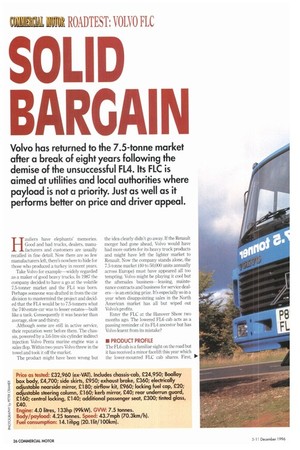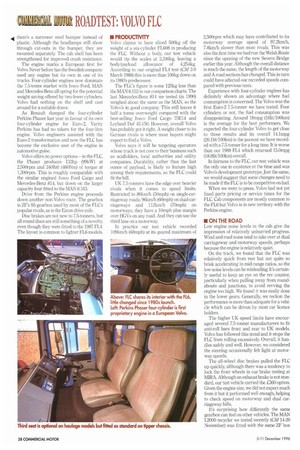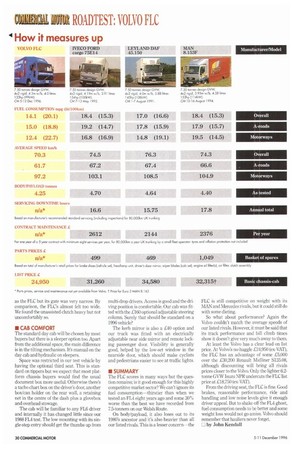SOL ID
Page 28

Page 30

Page 32

If you've noticed an error in this article please click here to report it so we can fix it.
13IkIZGA
Volvo has returned to the 7.5-tonne market after a break of eight years following the demise of the unsuccessful FL4. Its FLC is aimed at utilities and local authorities where payload is not a priority. Just as well as it performs better on price and driver appeal.
Hauliers have elephants' memories. Good and bad trucks, dealers, manufacturers and customers are usually recalled in fine detail. Now there are so few manufacturers left, there's nowhere to hide for those who produced a turkey in recent years.
Take Volvo for example—widely regarded as a maker of good heavy trucks. In 1987 the company decided to have a go at the volatile 7.5-tonner market and the FL4 was born. Perhaps someone was drafted in from the car division to mastermind the project and decided that the FIA would be to 7.5-tonners what the 740 estate car was to lesser estates—built like a tank. Consequently it was heavier than average, slow and thirsty.
Although some are still in active service, their reputation went before them. The chassis, powered by a 3.6-litre six-cylinder indirect injection Volvo Penta marine engine was a sales flop. Within two years Volvo threw in the towel and took it off the market.
The product might have been wrong but the idea clearly didn't go away. If the Renault merger had gone ahead, Volvo would have had more outlets for its heavy truck products and might have left the lighter market to Renault. Now the company stands alone, the 7.5-tonne market (40 to 50,000 units annually across Europe) must have appeared all too tempting. Volvo might be playing it cool but the aftersales business—leasing, maintenance contracts and business for service dealers—is an enticing prize. It's especially so in a year when disappointing sales in the North American market has all but wiped out Volvo's profits.
Enter the FLC at the Hanover Show two months ago. The lowered FL6 cab acts as a passing reminder of its FL4 ancestor but has Volvo learnt from its mistake?
• PRODUCT PROFILE The FL6 cab is a familiar sight on the road but it has received a minor facelift this year which
the lower-mounted FLC cab shares. First, 111" 411 there's a narrower steel bumper instead of plastic. Although the headlamps still show through cut-outs in the bumper. they are mounted separately. The cab shell has been strengthened for improved crash resistance.
The engine marks a European first for Volvo. Never before has the Swedish company used any engine but its own in one of its trucks. Four-cylinder engines now dominate the 7.5-tonne market with lveco Ford. MAN and Mercedes-Benz all opting for the potential weight saving offered by two fewer cylinders. Volvo had nothing on the shelf and cast around for a suitable donor.
As Renault dumped the four-cylinder Perkins Phaser last year in favour of its own four-cylinder engine for Euro-2, Varity Perkins has had no takers for the four-litre engine. Volvo engineers assisted with the Euro-2 transformation and now the FLC has become the exclusive user of the engine in automotive guise.
Volvo offers no power options—in the FLC, the Phaser produces 133hp (99kW) at 2,500rpm and 3401bft (460Nm) of torque at 1,300rpm. This is roughly comparable with the similar erigined Iveco Ford Cargo and Mercedes-Benz 814, but down on the larger capacity four fitted to the MAN 8.163.
Drive from the Perkins engine proceeds down another non-Volvo route. The gearbox is ZF's S5 gearbox used by most of the FI.C's popular rivals, as is the Eaton drive axle.
Disc brakes are not new to 7.5-tonners, but all-round discs are still something of a novelty, even though they were fitted to the 1987 FIA. The layout is common to lighter FL6 models. • PRODUCTIVITY
Volvo claims to have sliced 500kg off the weight of a six-cylinder FL608 in producing the FLC. Without a body, our test vehicle would tip the scales at 3246kg, leaving a body/payload allowance of 4,254kg. According to our original FL4 test (CM 3-9 March 1988) this is more than 100kg down on its 1980's predecessor.
The FLC's figure is some 125kg less than the MAN 8.163 in our comparison charts. The last Mercedes-Benz 814 we tested (in 1990) weighed about the same as the MAN, so the Volvo's in good company. This still leaves it half a tonne overweight compared with the best-selling lveco Ford Cargo 75E14 and Leyland Daf 45.150. However, overall Volvo has probably got it right. A weight closer to its German rivals is where most buyers might expect to find a Volvo.
Volvo says it will he targeting operators whose truck is not core to their business such as scaffolders, local authorities and utility companies. Durability, rather than the last ounce of payload, is likely to feature high among their requirements, so the FLC could fit the bill.
UK 7.5-tonners have the edge over heavier rivals when it comes to speed limits. Restricted to 80kin/h (50mph) on single-carriageway roads, 96km/h (60mph) on dual-carriagewavs and 112km/h (70mph) on motorways, they have a lOmph plus margin over HGVs on any road. And they can use the third lane on a motorway.
In practice our test vehicle recorded 109km/h (68mph) at its geared maximum of 2,500rpm which may have contributed to its motorway average speed of 97.2km/h, 7-8km/h slower than most rivals. This was also the first time we had run the Welsh Route since the opening of the new Severn Bridge earlier this year. Although the overall distance is much the same, the length of the motorway and A-road sections has changed. This in turn could have affected our recorded speeds compared with previous tests.
Experience with four-cylinder engines has definitely shown an advantage where fuel consumption is concerned. The Volvo was the first Euro-2 7,5-tonner we have tested. Four cylinders or not, the fuel consumption was disappointing. Around 18mpg (161it/100km) is the average for the best performers. We expected the four-cylinder Volvo to get close to those results and its overall 14.1mpg (20.11it/100km) is the poorest we have recorded with a 7.5-tonner for a long time. It is worse than our 1988 FIA which returned 15.0mpg (18,81it/100km) overall.
In fairness to the FLC, our test vehicle was the only one in existence at the time and was Volvo's development prototype. Just the same, we would suggest that some changes need to be made if the FLC is to be competitive on fuel.
When we went to press, Volvo had not yet fixed parts pricing or service times for the FLC. Cab components are mostly common to the FL6 but Volvo is in new territory with the Perkins engine.
• ON THE ROAD Low engine noise levels in the cab give the impression of relatively unhurried progress. Wind and road noise tend to take over at dual carriageway and motorway speeds, perhaps because the engine is relatively quiet.
On the track, we found that the FLC was relatively quick from rest but not quite so brisk accelerating in mid-range ratios, so the low noise levels can be misleading. It certainly useful to keep an eye on the rev counter, particularly when pulling away from roundabouts and junctions, to avoid revving the engine too high. We found it was easily done in the lower gears. Generally, we reckon the performance is more than adequate for a vehicle which can be driven by most car licence holders, The higher UK speed limits have encouraged several 7.5-tonner manufacturers to fit anti-roll bars front and rear to UK models. Volvo has followed this trend and it stops the FLC from rolling excessively. Overall, it handles safely and well. However, we considered the steering occasionally felt light at motorway speeds.
The all-wheel disc brakes pulled the FLC up quickly, although there was a tendency to lock the front wheels in our brake testing at MIRA. Although an exhaust brake is not standard, our test vehicle carried the £360 option. Given the engine size, we did not expect much from it but it performed well enough, helping to check speed on motorway and dual carriageway hills.
It's surprising how differently the same gearbox can feel on other vehicles. The MAN L2000 recycler we tested recently (CM 14-20 November) was fitted with the same ZF box
as the FLC but its gate was very narrow, By comparison, the FLC's almost felt too wide. We found the unassisted clutch heavy but not uncomfortably so.
• CAB COMFORT
The standard day cab will be chosen by most buyers but there is a sleeper option too. Apart from the additional space, the main difference is in the tilting mechanism. It's manual on the day cab and hydraulic on sleepers.
Space was restricted in our test vehicle by having the optional third seat. This is standard on tippers but we expect that most platform chassis buyers would find the usual document box more useful. Otherwise there's a tacho chart box on the driver's door, another box/can holder on the rear wall, a retaining net in the centre of the dash plus a glovebox and overhead stowage.
The cab will be familiar to any FL6 driver and internally it has changed little since our 1988 FIA test, The low mounting with its single-step entry should get the thumbs up from multi-drop drivers. Access is good and the
driving position is comfortable. Our cab was fitted with the £160 optional adjustable steering column. Surely that should be standard on a 1996 vehicle?
The kerb mirror is also a £40 option and our truck was fitted with an electrically adjustable near side mirror and remote locking passenger door. Visibility is generally good, helped by the low-set window in the nearside door, which should make cyclists and pedestrians easier to see at traffic lights.
• SUMMARY
The FLC scores in many ways but the question remains; is it good enough for this highly competitive market sector? We can't ignore its fuel consumption-thirstier than when we tested an FIA eight years ago and some 30% worse than the best we have recorded from 7.5-tormers on our Welsh Route.
On body/payload, it also loses out to its 1980's ancestor and it's also heavier than all our listed rivals. This is a lesser concernthe FLC is still competitive on weight with its MAN and Mercedes rivals, but it could still do with some dieting.
So what about performance? Again the Volvo couldn't match the average speeds of our listed rivals. However, it must be said that its track performance and hill climb times show it doesn't give very much away to them.
At least the Volvo has a clear lead on list price. At Volvo's no-haggle £24,950 (ex-VAT), the FLC has an advantage of some £5,000 over the £30,200 Renault Midliner S135.08, although discounting will bring all rivals prices closer to the Volvo. Only the lighter 6.2tonne GVW Isuzu NPR undercuts the FLC list price at £18,750 (ex-VAT).
From the driving seat, the FLC is fine. Good brakes, reasonable performance, ride and handling and low noise levels give it enough driver appeal. But to shake off the HA ghost, fuel consumption needs to be better and some weight loss would not go amiss. Volvo should remember that hauliers never forget.
by John Kendall








































































































